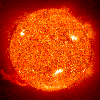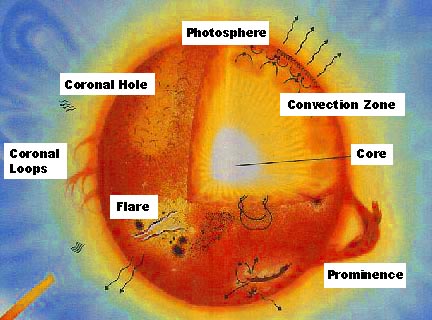 |
||
| First page | ||
 |
||
| Composition | ||
 |
||
| Activity | ||
 |
||
| The Sun as a star | ||
 |
||
| How/Why study? | ||
 |
Importance for us | |
 |
||
| Find out more | ||
 |
||
 |
||

Outer layers
The Sun's outer layers are known as it's atmosphere and they are the only layers we can observe directly. There are three main regions; the photosphere, the chromosphere and the corona.
This is what we see when we look at the Sun, and it's the lowest part of the atmosphere. It's not a sharp surface but consists of gas spanning a distance of almost 400 kilometers. The temperature here varies from 4000 degrees to almost 8000 degrees and the density also depends on how deep we dive into the Sun. Under good observing conditions with a telescope (with special dark filters for protection) it's possible to see a pattern called granulation. Each granule is almost 1000 km across and has a dark boundary. Granules form and disappear within a couple of minutes.
The ChromosphereThe Chromosphere lies immediately above the photosphere and consists of a less dense gas. It is visible only when the photosphere is blocked (for example during a solar eclipse). The Chromosphere is 2-3000 km thick and studies show that the temperature increases through the chromosphere, from 4200 degrees at the photosphere to 100,000 degrees at the upper levels of the Chromosphere.
The transition regionThe region in the solar atmosphere where the temperature changes from 10,000 degrees (typical of the chromosphere) to nearly a million degrees (characteristic of the corona) is called the transition region.
The CoronaThe chromosphere reaches into the outermost part of the atmosphere; the corona. It was first observed during solar eclipses (like the chromosphere) and it's been known for many centuries. Because of its high temperature, the solar corona is a source of x rays and a photo of it shows that the corona has loops and both dark and bright regions.
You might think it seems weird that the outer layers are hotter than the surface of the Sun (which is "only" 6000 degrees). This problem still waits for an answer, but it seems to be magnetic energy that turns into heat energy.
The interior
Since the Sun is very hot we can't take a sample of it's "surface" and see what's in it, so instead scientists use spectroscopy, which means that they study the light that comes from the Sun. From that they've discovered that it consists of more that 60 elements, but 98 % of it is hydrogen and helium.
Never look at the Sun directly. Doing so will destroy the retinas of your eyes.
10th September 2000
Sarah Amandusson
www_astro@mssl.ucl.ac.uk